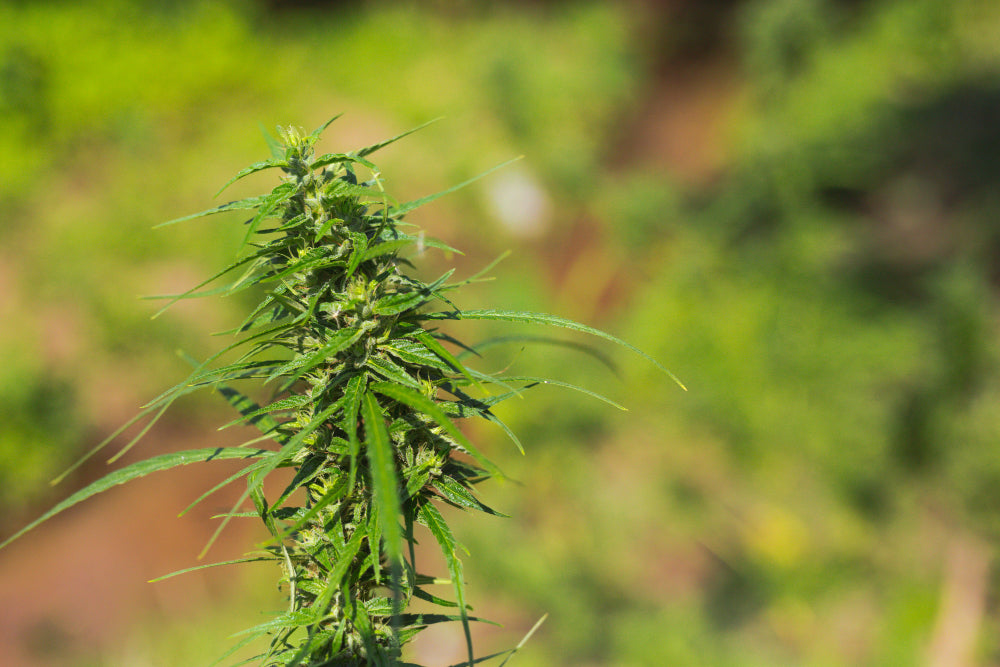CB9: A new cannabinoid

In the ever-evolving world of cannabinoids, a new, intriguing player is emerging: CB9. This cannabinoid, which has only recently gained wider attention, promises to redefine the way we think about cannabis and its diverse components. Unlike the more well-known cannabinoids THC and CBD, CB9 offers a unique combination of properties that make it interesting for both scientific research and potential therapeutic applications.
What is CB9?
CB9, a derivative of CBD (cannabidiol) found in the cannabis plant, is one of over 100 identified cannabinoids. Its chemical structure is similar to that of CBD, but features a natural 5-carbon chain that distinguishes it from its cannabinoid relatives. This slight structural change causes CB9 to possess psychoactive properties, unlike CBD, making it a subject of particular interest.
CB9 is produced through a complex chemical reaction within the cannabis plant in which other cannabinoids such as THC and CBD serve as precursors. The exact mechanisms of CB9 formation are still the subject of ongoing research. One of the outstanding properties of CB9 is that, unlike many other cannabinoids, it does not crystallize, which sets it apart from its counterparts and raises new questions regarding its storage and processing.
Psychoactive properties of CB9
Although CB9 has structural similarities to CBD and H4CBD, its psychoactive properties clearly distinguish it from them. CB9 offers a milder psychoactive experience compared to THC, making it attractive to users seeking relaxation, euphoria, or a slightly altered sensory perception without experiencing the more intense effects of THC. These properties could make CB9 a preferred choice for those seeking the benefits of cannabis without the strong “high.”
Therapeutic potential of CB9
The discovery of CB9 sheds new light on the already diverse world of cannabinoids. Compared to its better-known relatives such as CBD and THC, CB9 offers unique properties that make it particularly interesting for medical and therapeutic applications. In particular, its potential in the areas of pain relief and anti-inflammatory properties is the focus of current research.
Pain relief and anti-inflammatory
The ability of cannabinoids to relieve pain and modulate inflammatory responses is well documented. CB9, with its specific chemical properties, could open up new possibilities in this area.
Pain relief
Chronic pain is a challenge for modern medicine because it is often difficult to treat and can significantly affect the quality of life of those affected. Finding effective painkillers that do not lead to dependence or serious side effects is therefore of great importance. CB9 could play a role here by offering an alternative to traditional painkillers. Research has yet to show how CB9 works in detail, but the hope is that it can effectively modulate pain signals without causing the typical side effects of opioids or NSAIDs (non-steroidal anti-inflammatory drugs).
Anti-inflammatory
Inflammation is the body's natural response to injury and infection, but can cause lasting damage in chronic conditions such as arthritis, asthma or autoimmune diseases. Through its anti-inflammatory properties, CB9 could help modulate the underlying inflammatory processes, thereby alleviating symptoms and improving quality of life. By potentially acting on the same or similar signaling pathways as CBD, CB9 could be a valuable addition to existing treatment methods, particularly for patients who do not respond to conventional therapies.
Research is still in its early stages and further studies are needed to understand the full potential of CB9 in these areas. However, evidence to date suggests that CB9 has the potential to become an important player in the future of cannabinoid-based therapies. The unique properties of CB9 open up new avenues for the treatment of pain and inflammation that could improve the well-being of patients worldwide.
Stress and anxiety relief
The potential benefits of CB9 in treating stress and anxiety open up exciting prospects. Anxiety disorders are among the most common mental illnesses worldwide and can have a significant impact on daily life. The search for effective but gentle treatment methods is therefore of great importance. CB9 could play an important role here, as preliminary research suggests that it may have anti-anxiety effects similar to CBD, but with the added benefit of mild psychoactive properties that promote relaxation without impairing cognitive abilities.
The effect of CB9 on the central nervous system, and particularly on the mechanisms that regulate anxiety and stress, is a promising area of research. By modulating the endocannabinoid system, CB9 could help normalize the body's response to stress and restore balance disrupted by chronic stress or anxiety. It is important that further studies be conducted to understand these effects and how CB9 can be targeted to support stress and anxiety.
Improving sleep quality
Sleep is a fundamental aspect of human health, but sleep disorders are a widespread problem. From difficulty falling asleep to consistent sleep cycle interruptions, the impact on health and daily well-being can be significant. CB9 could also provide valuable support here. By potentially providing calming effects, CB9 could help improve the quality of sleep by promoting the relaxation necessary for sleep and potentially making it easier to fall asleep.
Research into the specific effects of CB9 on sleep is still in its early stages, but the connection between the endocannabinoid system and sleep regulation is well established. CB9 may interact in a way that supports the natural sleep cycle without causing the negative side effects of traditional sleep aids. This would make it an attractive option for people looking for natural alternatives to improve their sleep quality.
Is CB9 legal?
In addition to the medical and therapeutic possibilities, the introduction of CB9 into the cannabinoid market also brings with it a variety of legal challenges and questions. The legal framework for cannabinoids varies widely around the world and is often in a state of development and change.
Legislation and Regulation
The legal status of CB9 varies from country to country and often depends on the specific classification of cannabis and its derivatives. In some countries, cannabinoids such as CBD are covered by certain legal regulations that allow their sale and use under certain conditions. However, because CB9 has a psychoactive component, it may be subject to stricter regulations in some regions.
It is important for producers and consumers of CB9 products to thoroughly inform themselves about local laws and regulations. In countries where cannabis has been legalized for medical use, products containing CB9 may be more accessible, provided they meet the necessary standards and regulations. However, ever-changing laws require continuous monitoring of the legal landscape.
Where can I buy CB9?
Despite the legal challenges, the availability of CB9 products on the market is increasing. These range from oils and tinctures to edibles and topicals. The specific products available and their composition may vary depending on regulatory requirements in different regions.
Manufacturers of CB9 products must ensure that their products meet local regulatory requirements for purity, labeling and advertising. Consumers interested in using CB9 should only purchase products from reputable sources that can demonstrate compliance with applicable laws and standards.
Growing recognition of the potential benefits of cannabinoids such as CB9 could lead to easing of regulatory restrictions and wider availability of these products. While the legal landscape remains a complex area, it is a promising sign that research and discussions on cannabinoids like CB9 are progressing, potentially leading to greater understanding and acceptance.
Future of CB9
The discovery and increasing interest in CB9 marks an exciting turning point in cannabis research and application. While initial findings about the properties and potential applications of CB9 are already available, research in this area is still in its early stages. The future of CB9 could have far-reaching implications for medicine, the pharmaceutical industry and society as a whole.
Research needs
The need for further scientific research to understand the full potential of CB9 cannot be overstated. There is a significant need for detailed studies addressing the precise mechanisms by which CB9 works in the body, particularly with regard to its interaction with the endocannabinoid system. Additionally, research is needed on the long-term health effects of CB9, possible side effects, and optimal dosage. Such research is critical to safely and effectively integrating CB9 into therapeutic protocols.
Market potential
The market potential of CB9 products is significant. Given the growing interest in cannabinoids for a variety of applications, CB9-based products could play an important role in the next generation of cannabis products. This could include the development of new formulations for medical applications, wellness and lifestyle products that benefit from CB9's unique properties. CB9's ability to combine mild psychoactive effects with potential therapeutic benefits, without the typical side effects of more potent psychoactive substances, makes it an attractive candidate for a wide range of consumers and patients.
Future research and development in the area of CB9 faces exciting challenges and opportunities. As science and technology advances, supported by a changing legal landscape, CB9 could play a key role in shaping the future of cannabinoids and their use. Advances in this area could not only open up new therapeutic options, but also help destigmatize cannabis and promote its acceptance as a valuable resource for health and well-being.
Conclusion
The discovery and growing interest in CB9 reflects the continued evolution in the understanding and use of cannabinoids. CB9, with its unique properties and potential for medical and therapeutic applications, is the focus of current research and discussion. The ability to combine mild psychoactive effects with potential health benefits, without the strong psychoactive reactions associated with other cannabinoids, makes CB9 a promising candidate for future developments in the field of cannabinoid-based products.
However, research into CB9 is still at an early stage. There is a significant need for further scientific research to fully understand the mechanisms of action, safety, effectiveness, and long-term effects of CB9. This research will be critical to unlocking the therapeutic potential of CB9 and guiding its application in medicine and other fields.
At the same time, the legal status of CB9 raises questions that are answered differently in different regions. The legal and regulatory landscape for cannabinoids is complex and subject to constant change. Clear and consistent regulation is needed to promote the development and availability of CB9 products while ensuring consumer safety.
The future of CB9 and its applications is promising, with the potential to enrich the cannabinoid market and provide new therapeutic options for a variety of diseases. Advances in research and development, along with progressive regulatory regulation, will pave the way for CB9 as an important component in the next generation of cannabinoid-based therapies.





